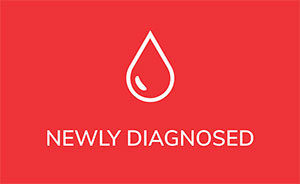We don’t know exactly what causes chronic lymphocytic leukemia (CLL), but the science suggests that there might be a genetic component to it. If you have a parent or sibling with CLL, you are at greater risk of developing CLL yourself. This implies that something about your family’s genes might be putting you at higher risk for developing CLL.
Germline DNA is the DNA parents pass on to their progeny, and it is the source of DNA for all cells in the body. Genetic variations that are present in your parents’ DNA can be passed down to you through germline DNA.
One particular gene that scientists are interested in studying for its potential role in cancer development is the ATM gene. ATM assists cells in recognizing damaged or broken DNA strands and then coordinates DNA repair by activating enzymes that fix the broken strands. This helps maintain the stability of the genetic information contained in DNA and helps prevent potentially harmful changes. When ATM is not functioning properly, mutations can accumulate and may lead to unregulated cell growth and cancer formation.
At the annual meeting of the American Society of Hematology (ASH) 2019, our own Dr. Brian Koffman interviewed Dr. Jennifer Brown, Director of the CLL Center at Dana-Farber Cancer Institute and Professor of Medicine at Harvard Medical School. They discussed how inherited genetic variation in the ATM gene may influence who develops CLL.
Takeaways:
- We have known for some time that ATM may be involved in CLL because with the chromosome 11q deletion, a copy of the ATM gene is knocked out.
- ATM is a tumor-suppressor gene, which means that when it is present and functioning normally it helps to prevent the development of cancer. If one or two copies of the gene are lost, that makes it easier for cancer to develop.
- ATM can be inherited in its lost state (ie, one copy is already missing in the germline DNA)
- Dr. Brown and colleagues previously compared germline mutations in patients with CLL with controls who did not have cancer. The top gene missing in patients with CLL was ATM.
- Now Dr. Brown and colleagues are comparing the germline DNA of patients with CLL with patients who have other lymphomas or myeloid cancers
- They have found that approximately 1 in 4 patients with CLL has a mutation in their ATM gene that they were born with.
- In comparison, only about 12-15% of patients with other lymphomas/myeloid cancers have a mutation in their ATM gene.
Conclusions:
Figuring out what causes a disease as complex as cancer is incredibly challenging, because there are so many potential contributors. As technologies improve in science and medicine, we are better able to study potential contributors such as specific gene variants. ATM clearly plays an important role as a tumor-suppressor gene, and Dr. Brown’s research indicates that certain germline ATM gene variants are contributors to inherited risk of developing CLL.
Please enjoy this interview with Dr. Brown from December 2019 at ASH in Orlando, FL.
You can read the actual ASH abstract here: Incidence of Germline ATM Variants in a Consecutive Clinical Cohort of CLL Patients
Take care of yourself first.
Ann Liu, PhD



